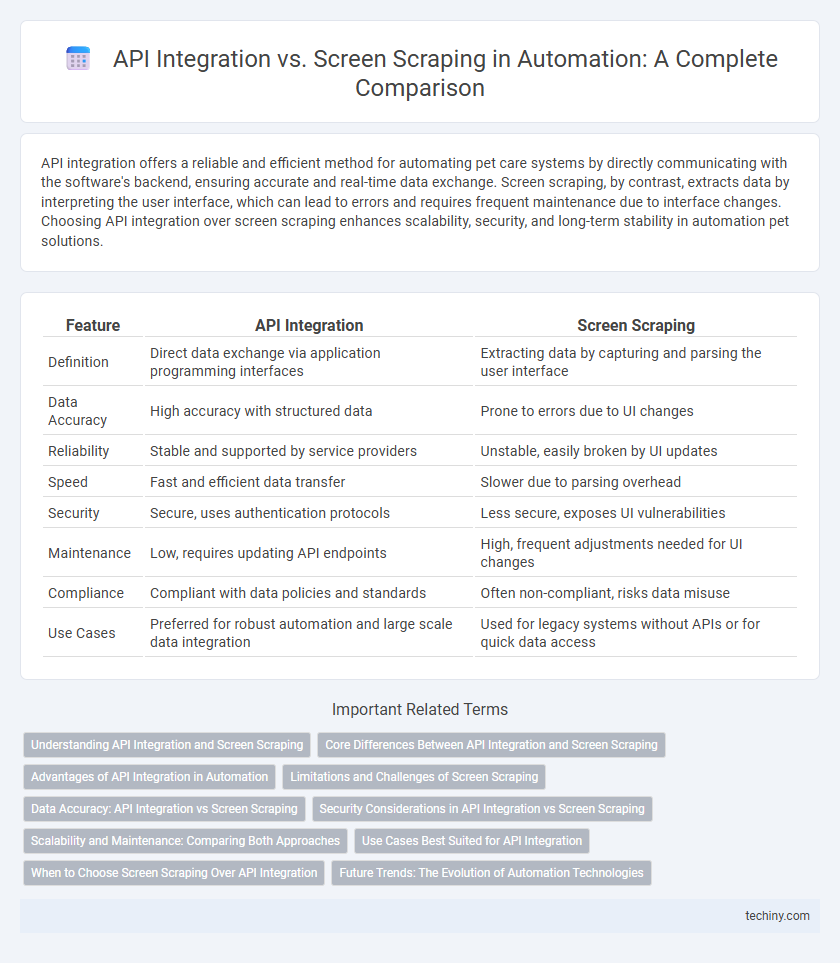API integration offers a reliable and efficient method for automating pet care systems by directly communicating with the software's backend, ensuring accurate and real-time data exchange. Screen scraping, by contrast, extracts data by interpreting the user interface, which can lead to errors and requires frequent maintenance due to interface changes. Choosing API integration over screen scraping enhances scalability, security, and long-term stability in automation pet solutions.
Table of Comparison
| Feature | API Integration | Screen Scraping |
|---|---|---|
| Definition | Direct data exchange via application programming interfaces | Extracting data by capturing and parsing the user interface |
| Data Accuracy | High accuracy with structured data | Prone to errors due to UI changes |
| Reliability | Stable and supported by service providers | Unstable, easily broken by UI updates |
| Speed | Fast and efficient data transfer | Slower due to parsing overhead |
| Security | Secure, uses authentication protocols | Less secure, exposes UI vulnerabilities |
| Maintenance | Low, requires updating API endpoints | High, frequent adjustments needed for UI changes |
| Compliance | Compliant with data policies and standards | Often non-compliant, risks data misuse |
| Use Cases | Preferred for robust automation and large scale data integration | Used for legacy systems without APIs or for quick data access |
Understanding API Integration and Screen Scraping
API integration involves direct communication between software applications using defined protocols, enabling seamless data exchange and real-time synchronization. Screen scraping extracts data by capturing display content from the user interface, often less reliable and prone to breaking with UI changes. Understanding these methods clarifies automation capabilities, highlighting API integration's efficiency and robustness compared to the more fragile and limited screen scraping approach.
Core Differences Between API Integration and Screen Scraping
API integration enables direct, secure communication between software systems through structured data exchange, ensuring reliability and real-time access. Screen scraping extracts data by mimicking user interactions with graphical interfaces, which can lead to errors due to layout changes and lacks official support. Core differences include data accuracy, stability, security, and scalability, with API integration providing superior robustness and efficiency over screen scraping.
Advantages of API Integration in Automation
API integration in automation offers seamless and direct communication between software applications, ensuring higher data accuracy and real-time updates compared to screen scraping. It provides enhanced security through standardized authentication protocols like OAuth and eliminates the fragility associated with UI changes that often break screen scraping scripts. This approach significantly improves scalability and maintenance efficiency, enabling businesses to automate workflows more reliably and effectively.
Limitations and Challenges of Screen Scraping
Screen scraping faces significant limitations such as fragility due to frequent UI changes that cause data extraction failures and increased maintenance costs. It struggles with scalability since each new screen or application requires custom parsers and adjustments, limiting automation efficiency. Moreover, screen scraping often lacks robust security, leading to potential data breaches and compliance issues compared to API integration's structured access and authentication mechanisms.
Data Accuracy: API Integration vs Screen Scraping
API integration ensures higher data accuracy by directly accessing structured data endpoints, reducing the risk of errors caused by interface changes or data formatting inconsistencies. Screen scraping relies on parsing visual elements, which is prone to inaccuracies due to layout shifts, missing data, or ambiguous parsing rules. Enterprises seeking reliable automation prioritize API integration to maintain data integrity and support real-time updates without manual intervention.
Security Considerations in API Integration vs Screen Scraping
API integration offers enhanced security by using authentication protocols such as OAuth and API keys, ensuring encrypted data transmission and controlled access. Screen scraping exposes systems to higher risks due to direct interaction with the user interface, increasing vulnerability to data breaches and inconsistent data extraction. Enterprises prioritize API integration to maintain compliance with data protection regulations and minimize exposure to cyber threats.
Scalability and Maintenance: Comparing Both Approaches
API integration offers superior scalability and maintenance advantages by providing structured, consistent access to data with minimal changes required as systems evolve. Screen scraping, while often quicker to implement, struggles with scalability due to its reliance on UI structures that frequently change, leading to higher maintenance demands and increased risk of failures. Enterprises prioritizing long-term efficiency typically prefer API integration for its robustness and ease of updates across growing digital ecosystems.
Use Cases Best Suited for API Integration
API integration is best suited for use cases requiring real-time data exchange, high reliability, and complete access to application features, such as financial services, e-commerce platforms, and CRM systems. It enables seamless automation of workflows by providing structured, consistent data retrieval and updates directly from the source system. Organizations aiming for scalability, data accuracy, and secure operations highly benefit from API integration over screen scraping.
When to Choose Screen Scraping Over API Integration
Screen scraping is preferable when dealing with legacy systems or applications lacking robust, accessible APIs, enabling data extraction directly from the user interface without requiring backend access. It proves valuable in scenarios where APIs are unavailable, unreliable, or impose strict usage limits, allowing continuous automated data retrieval despite these restrictions. Choosing screen scraping ensures integration with proprietary or closed platforms and supports real-time data capture from dynamic web pages inaccessible via API calls.
Future Trends: The Evolution of Automation Technologies
API integration is rapidly becoming the preferred method for automation due to its reliability, security, and seamless data exchange capabilities with modern software systems. Screen scraping, while still used for legacy applications lacking APIs, faces limitations in scalability and data accuracy as automation evolves. Future trends emphasize the adoption of intelligent API-driven automation platforms enhanced by AI and machine learning to improve efficiency and adaptability across diverse enterprise environments.
API Integration vs Screen Scraping Infographic

 techiny.com
techiny.com